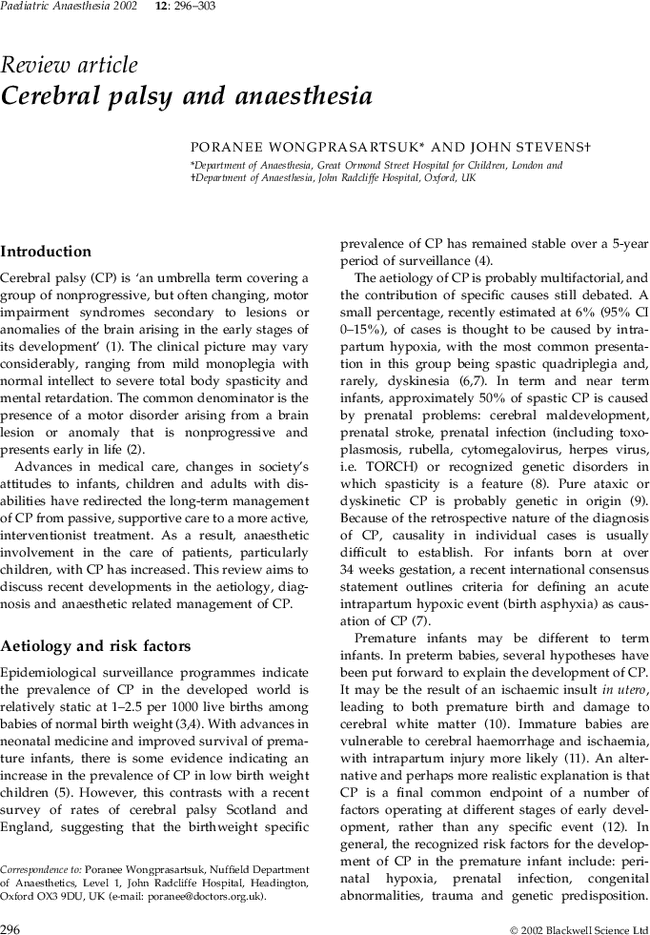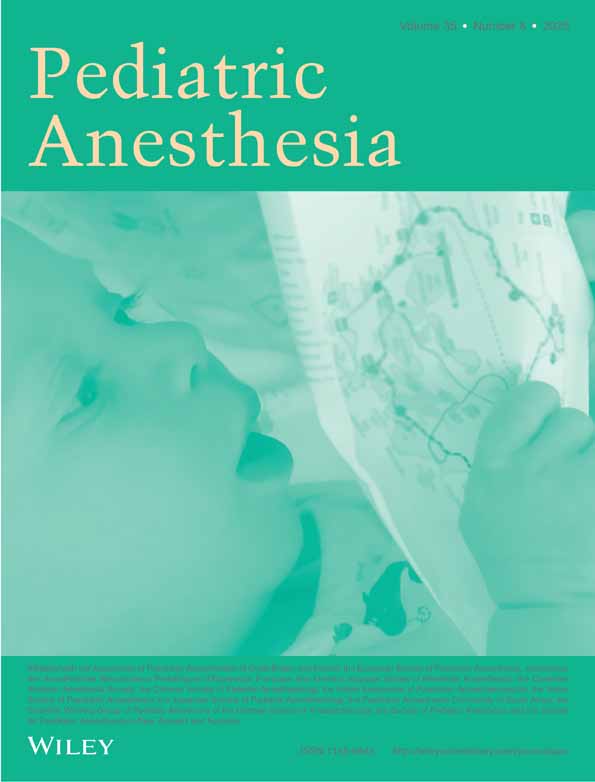Cerebral palsy and anaesthesia
PORANEE WONGPRASARTSUK,
JOHN STEVENS,
PORANEE WONGPRASARTSUK
Department of Anaesthesia, Great Ormond Street Hospital for Children, London,
Search for more papers by this authorJOHN STEVENS
Department of Anaesthesia, John Radcliffe Hospital, Oxford, UK
Search for more papers by this authorPORANEE WONGPRASARTSUK,
JOHN STEVENS,
PORANEE WONGPRASARTSUK
Department of Anaesthesia, Great Ormond Street Hospital for Children, London,
Search for more papers by this authorJOHN STEVENS
Department of Anaesthesia, John Radcliffe Hospital, Oxford, UK
Search for more papers by this author
Poranee Wongprasartsuk,
Nuffield Department of Anaesthetics, Level 1, John Radcliffe Hospital, Headington, Oxford OX3 9DU, UK (e-mail: [email protected]).

References
- 1 Mutch I, Alberman E, Hagberg B et al. Cerebral palsy epidemiology: where are we now and where are we going? Dev Med Child Neurol 1992; 34 : 547–555.
- 2 Badawi N, Watson L, Petterson B et al. What constitutes cerebral palsy? Dev Med Child Neurol 1998; 40 : 520–527.
- 3 Paneth N, Stark RI. Cerebral palsy and mental retardation in relation to indicators of perinatal asphyxia. Am J Obstet Gynecol 1983; 147 : 960–966.
- 4 Pharoah POD, Cooke T, Johnson MA et al. Epidemiology of cerebral palsy in England and Scotland 1984–9. Arch Dis Child Fetal Neonatal Ed 1998; 79 : F21–F25.
- 5 Dite GS, Bell R, Reddihough DS et al. Antenatal and perinatal antecedents of moderate and severe spastic cerebral palsy. Aust NZ J Obstet Gynaecol 1998; 38 : 377–383.
- 6 Nelson KB, Grether JK. Potentially asphyxiating conditions and spastic cerebral palsy in infants of normal birthweight. Am J Obstet Gynecol 1998; 179 : 507–513.
- 7 MacLennan A, International Cerebral Palsy Task Force. A template for defining a causal relation between acute intrapartum events and cerebral palsy: international concensus statement. BMJ 1999; 319 : 1054–1059.
- 8 Nelson KB, Grether JK. Maternal infection and cerebral palsy in infants of normal birthweight. JAMA 1997; 278 : 207–213.
- 9 Steinlin M. Non-progressive congenital ataxias. Brain Dev 1998; 20 : 199–205.
- 10 Pharoah POD, Cooke T, Cooke RW et al. Birthweight specific trends in cerebral palsy. Arch Dis Child 1990; 65 : 602–606.
- 11 Leviton A, Paneth N. White matter damage in preterm newborns: an epidemiologic perspective. Early Hum Dev 1990; 24 : 1–22.
- 12 Murphy DJ, Hope PL, Johnson A. Neonatal risk factors for cerebral palsy in very preterm babies: case control study. BMJ 1997; 314 : 404–408.
- 13 Gray PH, O'Callaghan MJ, Mohay HA et al. Maternal hypertension and neurodevelopmental outcome in very preterm infants. Arch Dis Child Fetal Neonatal Ed 1998; 79 : F93F93.
- 14 Albright LA. Cerebral palsy: approaches to drug treatment. Pract Therapeut 1995; 4 : 17–27.
- 15
Collier J, ed. The management of spasticity.
Drug Therapeut Bull
2000; 38
:
44–46.
10.1136/dtb.2000.38644 Google Scholar
- 16 Gordon N. The role of botulinus toxin type A in treatment – with special reference to children. Brain Dev 1999; 21 : 147–151.
- 17 Koman LA, Mooney JF, Smith BP et al. BOTOX study group. Botulinum toxin type A neuromuscular blockade in the treatment of lower extremity spasticity in cerebral palsy: a randomised double-blind, placebo-controlled trial. J Pediatr Orthop 2000; 20 : 108–115.
- 18 Barwood S, Baillieu C, Brereton K et al. Analgesic effects of botulinum toxin A. a randomized, placebo-controlled clinical trial. Dev Med Child Neurol 2000; 42 : 116–121.
- 19 Khoshoo V, Edell D, Clarke R. Effect of cisapride on the QT interval in infants with gastroesophageal reflux. Pediatrics 2000; 105 : E24E24.
- 20 Levine A, Fogelman R, Sirota L et al. QT interval in children and infants receiving cisapride. Pediatrics 1998; 101 : E9E9.
- 21 Acharya S, Bussel JB. Hematologic toxicity of sodium valproate. J Pediatr Hematol Oncol 2000; 22 : 62–65.
- 22 Landwehr LP, Boguniewicz M. Current perspectives on latex allergy. J Pediatr 1996; 128 : 305–312.
- 23 Stasilkelis PJ, Lee DD, Sullivan CM. Complications of osteotomies in severe cerebral palsy. J Pediatr Orthop 1999; 19 : 207–210.
- 24 Lipton GE, Miller F, Dabney KW et al. Factors predicting postoperative complications following spinal fusions in children with cerebral palsy. J Spinal Disord 1999; 12 : 197–205.
- 25 Theroux MC, Brandon BW, Zagonev M et al. Dose response of succinyl choline at the adductor pollicus of children with cerebral palsy during propofol and nitrous oxide anesthesia. Anesth Analg 1994; 79 : 761–765.
- 26 Antognini JF, Gronert GA. Succinylcholine sensitivity in cerebral palsy. Anesth Analg 1995; 80 : 1248–1253.
- 27 Moorthy SS, Krishna G, Dierdorf S. Resistance to vecuronium in patients with cerebral palsy. Anesth Analg 1991; 73 : 275–277.
- 28 Frei FJ, Haemmerle MH, Brunner R et al. Minimum alveolar concentration for halothane in children with cerebral palsy and severe mental retardation. Anaesthesia 1997; 52 : 1056–1060.
- 29 Brenn BR, Brislin RP, Rose JB. Epidural analgesia in children with cerebral palsy. Can J Anaesth 1998; 45 : 1156–1161.
- 30 Albright LA. Neurosurgical treatment of spasticity: selective posterior rhizotomy and intrathecal baclofen. Steroetact Funct Neurosurg 1992; 58 : 3–13.
- 31 Reimers JI, Latocha JE. Incidence of inguinal hernia in children with congenital cerebral palsy. Dev Med Child Neurol 1990; 32 : 1058–1060.
- 32 Somri M, Gaitini L, Vaida S et al. Postoperative outcome in high-risk infants undergoing herniorrhaphy: comparison between spinal and general anaesthesia. Anaesthesia 1998; 53 : 762–766.
- 33 Rowney DA, Aldridge LM. Laparoscopic fundoplication in children: anaesthetic experience of 51 cases. Paed Anaesth 2000; 10 : 291–296.




